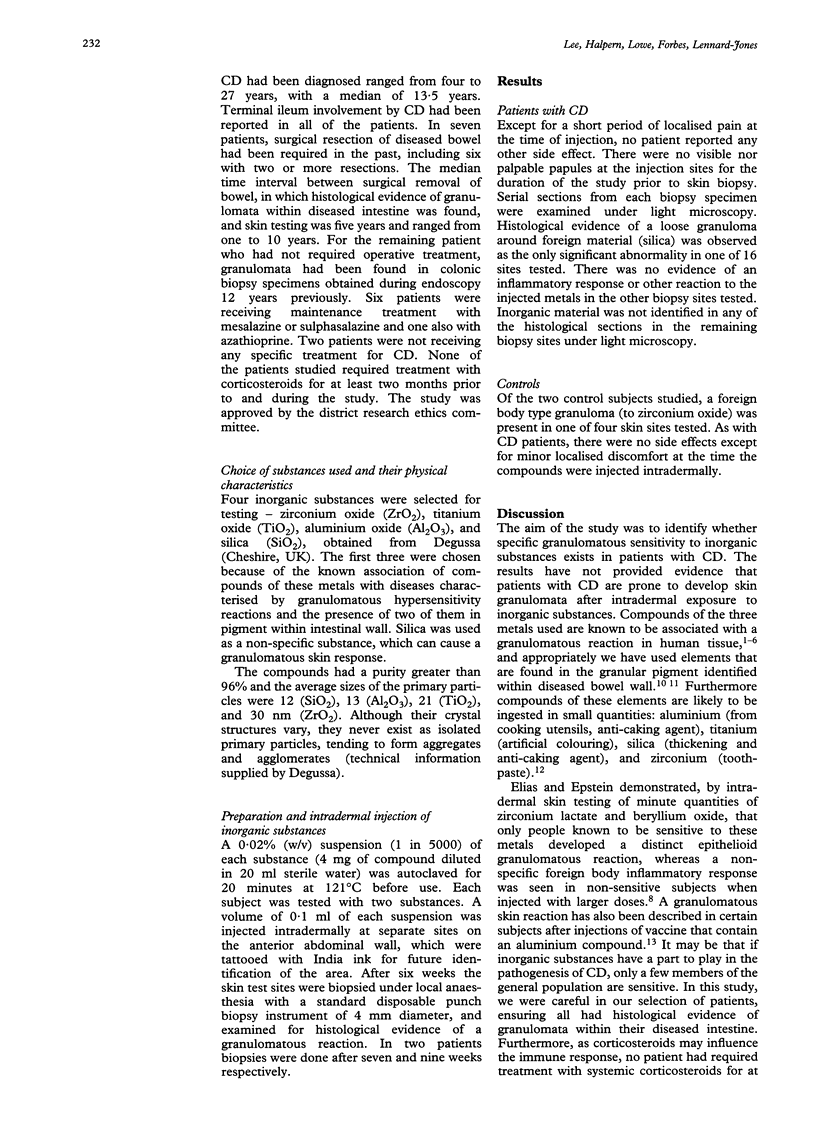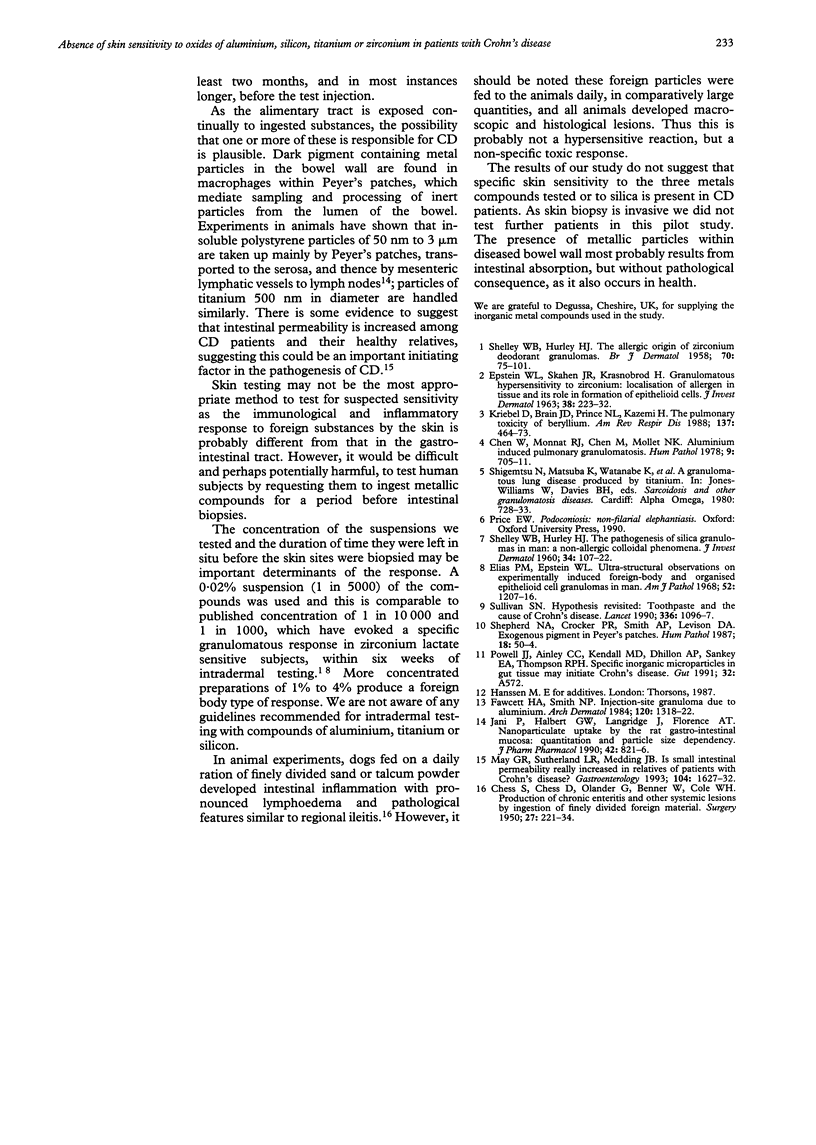Abstract
BACKGROUND: Some metallic compounds, especially of zirconium, can cause cell mediated granulomatous inflammation of the skin. Pigment granules containing compounds of aluminium, silicon, and titanium have been observed within macrophages in the wall of the small intestine in health and in Crohn's disease. Zirconium compounds can be ingested in toothpaste. AIM: To determine in a pilot study if granulomatous sensitivity can be detected to compounds of these metals or silicon after injection into the skin of patients with Crohn's disease. SUBJECTS: Eight patients with Crohn's disease known to have had granulomata in the intestine and not currently treated with corticosteroids, and two healthy controls. METHOD: Two intradermal injections each of 0.1 ml of a 0.02% suspension of one of the compounds made in the abdominal wall of each subject. The site was marked and full thickness skin biopsy performed six weeks later. RESULT: A foreign body granuloma was observed on histological examination of two biopsy specimens but no evidence of a cell mediated response in any subject. CONCLUSION: No support was found for the hypothesis that Crohn's disease is due to a specific sensitivity to ingested metallic or silicon compounds.
Full text
PDF


Selected References
These references are in PubMed. This may not be the complete list of references from this article.
- Chen W. J., Monnat R. J., Jr, Chen M., Mottet N. K. Aluminum induced pulmonary granulomatosis. Hum Pathol. 1978 Nov;9(6):705–711. doi: 10.1016/s0046-8177(78)80053-7. [DOI] [PubMed] [Google Scholar]
- EPSTEIN W. L., SKAHEN J. R., KRASNOBROD H. Granulomatous hypersensitivity to zirconium: localization of allergen in tissue and its role in formation of epithelioid cells. J Invest Dermatol. 1962 Apr;38:223–232. doi: 10.1038/jid.1962.40. [DOI] [PubMed] [Google Scholar]
- Elias P. M., Epstein W. L. Ultrastructural observations on experimentally induced foreign-body and organized epithelioid-cell granulomas in man. Am J Pathol. 1968 Jun;52(6):1207–1223. [PMC free article] [PubMed] [Google Scholar]
- Fawcett H. A., Smith N. P. Injection-site granuloma due to aluminum. Arch Dermatol. 1984 Oct;120(10):1318–1322. [PubMed] [Google Scholar]
- Jani P., Halbert G. W., Langridge J., Florence A. T. Nanoparticle uptake by the rat gastrointestinal mucosa: quantitation and particle size dependency. J Pharm Pharmacol. 1990 Dec;42(12):821–826. doi: 10.1111/j.2042-7158.1990.tb07033.x. [DOI] [PubMed] [Google Scholar]
- Kriebel D., Brain J. D., Sprince N. L., Kazemi H. The pulmonary toxicity of beryllium. Am Rev Respir Dis. 1988 Feb;137(2):464–473. doi: 10.1164/ajrccm/137.2.464. [DOI] [PubMed] [Google Scholar]
- May G. R., Sutherland L. R., Meddings J. B. Is small intestinal permeability really increased in relatives of patients with Crohn's disease? Gastroenterology. 1993 Jun;104(6):1627–1632. doi: 10.1016/0016-5085(93)90638-s. [DOI] [PubMed] [Google Scholar]
- SHELLEY W. B., HURLEY H. J. The allergic origin of zirconium deodorant granulomas. Br J Dermatol. 1958 Mar;70(3):75–101. doi: 10.1111/j.1365-2133.1958.tb13297.x. [DOI] [PubMed] [Google Scholar]
- SHELLEY W. B., HURLEY H. J. The pathogenesis of silica granulomas in man: a non-allergic collidial phenomenon. J Invest Dermatol. 1960 Feb;34:107–123. [PubMed] [Google Scholar]
- Shepherd N. A., Crocker P. R., Smith A. P., Levison D. A. Exogenous pigment in Peyer's patches. Hum Pathol. 1987 Jan;18(1):50–54. doi: 10.1016/s0046-8177(87)80193-4. [DOI] [PubMed] [Google Scholar]
- Sullivan S. N. Hypothesis revisited: toothpaste and the cause of Crohn's disease. Lancet. 1990 Nov 3;336(8723):1096–1097. doi: 10.1016/0140-6736(90)92572-y. [DOI] [PubMed] [Google Scholar]


